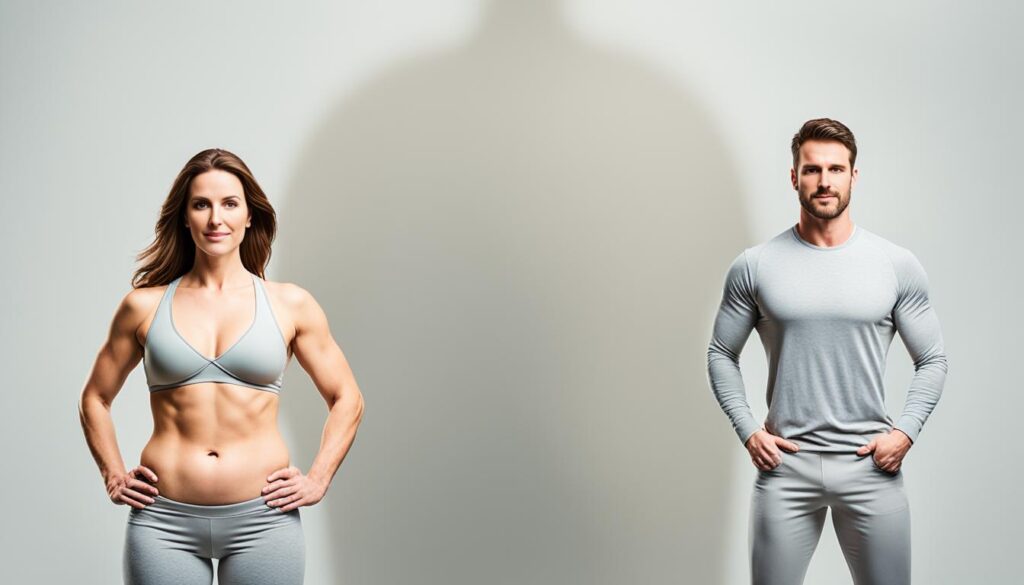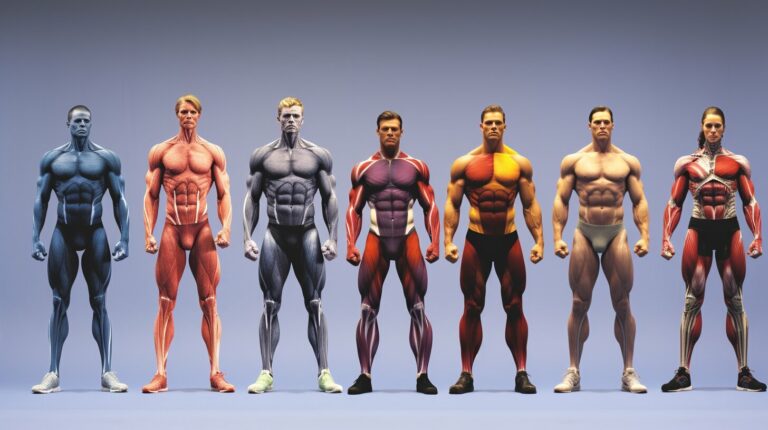Where Do You Lose Weight First?
When it comes to losing weight, many people wonder where they will lose weight first. While there is no definitive answer, several factors like genetics, sex, and age can influence where weight loss occurs. Genetics play a significant role in determining where fat is distributed in the body, and genetic factors may also affect weight loss. Additionally, men and women tend to lose weight in different areas, with women often losing weight in their legs first and men losing weight in their torsos. Age can also impact where weight loss occurs, with older individuals more likely to lose weight in the arms and legs. Overall, while it’s not possible to target specific areas for weight loss, understanding these factors can help inform weight loss strategies and expectations.
Key Takeaways:
- Genetics, sex, and age can influence where weight loss occurs in the body.
- Overall body fat reduction should be the primary goal, rather than targeting specific areas.
- Understanding these factors can help inform weight loss strategies and expectations.
- Regular exercise and a healthy diet are essential components of weight loss and overall health.
- Consulting with a healthcare professional or registered dietitian can provide personalized guidance for a weight loss journey.
The Role of Genetics in Weight Loss
Genetic factors play a significant role in determining body fat distribution and weight loss. Research has shown that the relationship between genes and body fat distribution is stronger in women than in men. For example, if individuals in your family tend to carry weight in certain areas, such as the hips and thighs, you may also experience weight gain in those areas.
Furthermore, genetic factors can influence the effectiveness of weight loss programs. If a specific type of diet, such as high protein or high fiber, has worked for your parents, there is a higher chance it may work for you as well.
“Genetics loads the gun, lifestyle pulls the trigger.” – Dr. Mehmet Oz
Ongoing research aims to further understand the role of genetics in personalizing weight loss programs. By analyzing an individual’s genetic makeup, scientists hope to develop personalized plans that take into account factors like metabolism, food cravings, and fat storage tendencies.
Personalizing Weight Loss Programs through Genetics
One company leading the way in personalized weight loss programs based on genetics is DNAFit. Through a simple DNA test, they analyze genetic markers related to body fat distribution, metabolism, and how your body responds to certain foods and exercise. With this information, they create a tailored plan that maximizes your weight loss potential.
For example, if the test reveals that you have a genetic predisposition for storing fat in your abdominal area, the weight loss program may focus on incorporating exercises that target core strength and reducing overall calorie intake to promote fat burning.
By leveraging genetic information, weight loss programs can be optimized to fit an individual’s unique needs and increase their chances of success.
Understanding the role of genetics in weight loss not only provides valuable insights into why some individuals struggle with stubborn fat in certain areas but also offers the potential for tailored solutions. With ongoing research and advancements in genetic testing, personalized weight loss programs can help individuals achieve their weight loss goals in a more efficient and effective manner.
| Genetic Factors | Impact on Weight Loss |
|---|---|
| Body fat distribution | Determines where fat is stored and lost |
| Metabolism | Affects how efficiently the body burns calories |
| Food cravings | Influences dietary choices and calorie intake |
| Response to exercise | Determines the effectiveness of different workout routines |
Difference in Weight Loss Between Men and Women
When it comes to weight loss, men and women often experience differences in their weight loss patterns. A worldwide study revealed that male participants tend to lose slightly more weight than females, even with less adherence to a low-calorie diet. This highlights the potential impact of sex on the rate of weight loss.
Men typically lose weight in their trunk area, which includes the abdomen and waist. On the other hand, women tend to lose weight in their hips, thighs, and buttocks. These differences in fat distribution can be attributed to biological factors, such as sex hormones and genetic predispositions.
While these patterns are commonly observed, it’s important to note that weight loss varies among individuals. Factors such as genetics, hormones, and overall body composition can influence where weight loss occurs. Therefore, it’s crucial to focus on overall weight loss and overall health rather than solely targeting specific areas.
“The differences in weight loss patterns between men and women can be influenced by a combination of genetic, hormonal, and environmental factors.”
To better understand the differences in weight loss between men and women, it’s helpful to consider the role of genetics. Genetic factors play a significant role in shaping body fat distribution and weight loss outcomes. These genetic factors may contribute to the observed differences in fat distribution patterns between the sexes.
While men may experience more significant weight loss in their trunk area, it doesn’t mean that women cannot achieve similar results. By focusing on overall weight loss through a combination of a healthy diet and regular exercise, both men and women can achieve their weight loss goals and improve their overall health.
Factors influencing weight loss patterns:
- Genetics
- Hormonal differences
- Body composition
- Overall lifestyle
As we continue to study the fascinating topic of weight loss, it becomes clear that there is much more to learn and understand about the complex interplay between sex, genetics, and fat distribution. However, what remains important is that achieving overall weight loss and improving overall health should be the primary focus.

The Impact of Age on Weight Loss
Age can play a significant role in the journey of weight loss. As we grow older, our body composition changes and the distribution of fat may shift. For some individuals, the waistline is often the first area to show noticeable changes when they embark on a weight loss journey. However, as we age further, weight tends to accumulate around the midsection.
This phenomenon is particularly true for middle-aged men and postmenopausal women. Studies have shown that postmenopausal women tend to store more fat around their midsections, making it challenging to achieve a toned abdomen. Additionally, muscle loss can become more prevalent as we age, further impacting body composition.
Incorporating exercise into a healthy diet is key to combatting these age-related weight loss challenges. Postmenopausal women, in particular, can benefit from regular physical activity that targets the abdominal muscles. By engaging in exercises such as abdominal crunches and planks, they can strengthen the core, improve muscle tone, and promote a healthier body composition.
Here is an example of a simple workout routine that postmenopausal women can follow to target their midsection:
- Basic crunches: Lie on your back with your knees bent and feet flat on the floor. Place your hands behind your head and gently lift your upper body off the floor, engaging your abdominal muscles. Repeat for 10-15 repetitions.
- Planks: Begin by assuming a push-up position, resting your forearms on the ground instead of your hands. Keep your body in a straight line from head to toe, engaging your core. Hold the position for 30 seconds to one minute.
- Leg raises: Lie flat on your back with your arms by your sides. Lift your legs off the ground, keeping them straight, until they are perpendicular to the floor. Slowly lower your legs back down without touching the ground. Repeat for 10-15 repetitions.
Remember to consult with a healthcare professional before starting any exercise program, especially if you have any pre-existing health conditions or concerns.
Benefits of Exercise in Aging Weight Loss
In addition to targeting specific problem areas, regular exercise offers various benefits for weight loss and overall health as we age. Some of the key benefits include:
- Improved metabolism: Exercise can help boost metabolism, allowing your body to burn more calories even at rest.
- Muscle preservation: Resistance training and weight-bearing exercises can help preserve muscle mass, which is essential for a healthy body composition.
- Enhanced cardiovascular health: Aerobic exercises like brisk walking, swimming, and cycling can improve heart health, lower blood pressure, and reduce the risk of cardiovascular diseases.
- Increased energy levels: Regular physical activity can boost energy levels and combat fatigue, allowing you to stay active and engaged in daily activities.
- Reduced risk of chronic diseases: Exercise has been linked to a lower risk of chronic conditions such as type 2 diabetes, certain cancers, and osteoporosis.
It’s important to note that weight loss and body composition changes take time, and consistency is key. Incorporating both cardiovascular exercises and strength training into your routine will help you achieve and maintain a healthy weight as you age.
“Exercise not only helps with weight loss but also improves overall well-being. By staying active and incorporating regular exercise into your daily routine, you can achieve a healthier body composition as you age.” – Fitness Expert
Remember, a balanced approach to weight loss that includes both diet and exercise is essential for long-term success. While we may not have control over where weight loss occurs first, focusing on overall weight loss and maintaining a healthy body composition can have significant benefits for our overall health and well-being.
Can Exercise Target Specific Areas for Weight Loss?
When it comes to weight loss, many people wonder if exercise can specifically target certain areas of the body. However, scientific evidence suggests that exercise, including spot reduction, is generally not effective in achieving targeted weight loss. Spot reduction refers to the idea that exercising specific muscles will result in fat loss in those areas.
Multiple studies have been conducted to investigate the concept of spot reduction, and the results consistently indicate that it is not supported by scientific evidence. One study, for example, focused on participants who only exercised their nondominant leg for 12 weeks. The findings showed that there was no significant difference in fat loss between the legs or in other areas of the body.
While exercise may not lead to spot reduction, it is important to note that it still offers numerous health benefits. Regular aerobic exercise, such as jogging, swimming, or cycling, can improve heart health, enhance brain function, and increase physical strength. Additionally, engaging in consistent exercise as part of an overall weight loss program can contribute to achieving your weight loss goals.

Conclusion
In conclusion, the process of weight loss is influenced by various factors such as genetics, sex, age, and overall body composition. While many individuals may desire to target specific areas for weight loss, it is crucial to prioritize overall weight loss and strive for a healthy body composition.
Excess weight, particularly around the midsection where visceral fat is located, can have severe health consequences, including an increased risk of diabetes and cardiovascular issues.
To achieve overall body fat reduction and improve overall health, it is essential to implement a healthy diet, engage in regular exercise, and adopt healthy lifestyle habits. Although one cannot control where weight loss occurs first, making positive changes to diet and exercise habits can have a holistic effect on the entire body by reducing overall body fat.
FAQ
Where do you lose weight first?
The location of weight loss varies among individuals and is influenced by factors such as genetics, sex, age, and overall body composition.
Can weight loss be targeted to specific areas?
It is not possible to target weight loss to specific areas. Overall weight loss and maintaining a healthy body composition should be the focus.
How do genetics impact weight loss?
Genetics play a role in determining body fat distribution and may influence the effectiveness of weight loss programs. Ongoing research aims to personalize weight loss programs based on genetic factors.
Do men and women lose weight differently?
Men and women tend to lose weight in different areas, with women often losing weight in their legs first and men losing weight in their torsos. However, these patterns can vary among individuals.
Does age affect where weight loss occurs?
As individuals age, their body composition changes, and weight loss may be more noticeable in the arms and legs. Older individuals may also store weight around their midsections.
Can exercise target specific areas for weight loss?
Exercise is not effective in targeting specific areas for weight loss. Spot reduction, the idea that exercising specific muscles will result in fat loss in those areas, is not supported by scientific evidence.
What should be the primary goal for weight loss?
The primary goals for weight loss should be overall weight loss and maintaining a healthy body composition. Extra weight around the midsection, particularly visceral fat, is associated with increased health risks.






